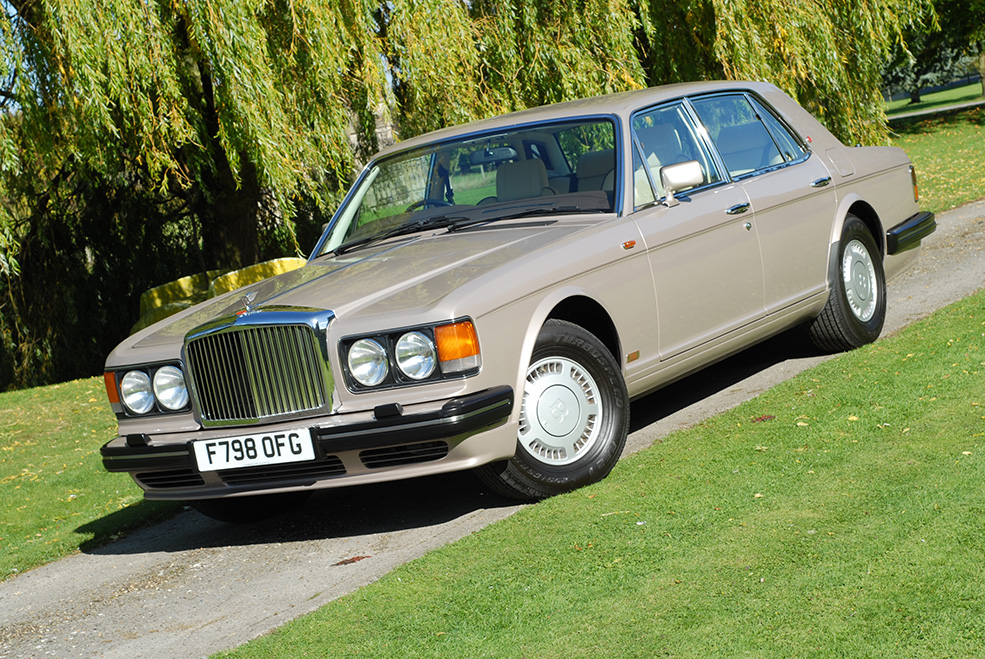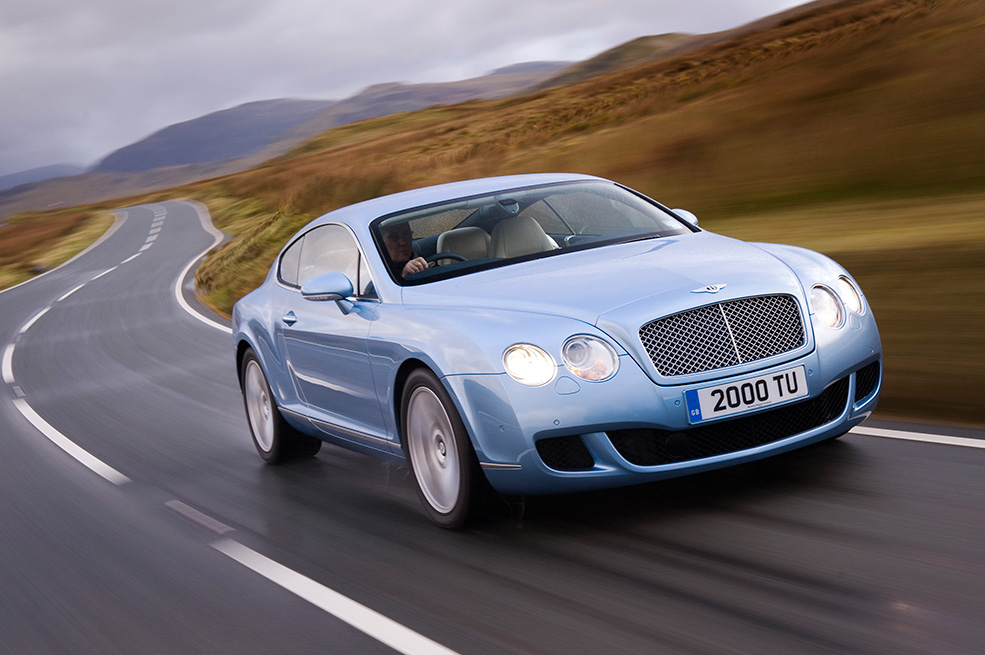Welcome to Old School vs New School where we visit the controversial subject of traditional classics compared to their more youthful equivalents. This time, the Bentley Turbo R and Bentley Continental GT versus the Bentley Arnage and Bentley Continental…
Just as today’s paper is tomorrow’s chip wrappers, so each modern classic will eventually take its accepted place in the line-up of cherished classics at a car show of the future and we’ve picked another selection we reckon offer a good illustration of the changing tastes.

OLD SCHOOL: BENTLEY TURBO R & BENTLEY CONTINENTAL GT
TECH SPEC – 1985 TURBO R
Engine: 6750cc V8
Power: 330bhp
Top speed: 143mph
Fuel consumption: 15mpg
Gearbox: Three-speed auto (1985-1992), Four-speed auto (1992 onwards)
TECH SPEC – 1991 CONTINENTAL R
Engine: 6750cc V8
Power: 360bhp
Top Speed: 151mph
Fuel consumption: 18mpg
Gearbox: Four-speed auto
A sales sensation for Bentley, the Turbo R and is all the more remarkable when you consider that it’s actually a great deal more ‘old school’ than you might otherwise think.
Based on the Rolls-Royce Silver Spirit, the Bentley Turbo R used the Rolls-Royce ‘SZ’ platform which traced its roots back to the firm’s first monocoque: 1965’s Silver Shadow (and later T Series). Suitably shortened, (with a consultant makeover courtesy of John Heffernan and Ken Greenley) the Continental R appeared in 1991; via R, T, SC and Azure variants, these underpinnings staggered on until VW’s new Continental was ready in 2003.
All of this was a far cry from Bentley’s cash strapped development programme in the Eighties: its parent Rolls-Royce was going through an uncertain time financially at the time of the Spirit’s development. With what money was available, the brief was to retain as much of the Shadow’s engineering as possible while updating its underpinnings.
This meant carrying over the long-serving six-and-three-quarters V8 and GM Hydramatic transmission, with power output traditionally stated as being merely ‘adequate’. This translated to around 220bhp in reality, but the Spirit/Mulsanne was a heavy car and rivals from Mercedes and Jaguar could show it a clean pair of heels in a straight line. Even in 1980, the Mulsanne was easily outpaced.
No doubt fearful of offending the conservative Rolls-Royce clientele, the firm chose the moribund Bentley for early experiments in creating a more powerful variant. A new engine was out of the question, so thoughts turned to extracting more power from the V8. With development work carried out by Broadspeed using a Silver Shadow and Camargue as a base, a 10 per cent uplift in power was delivered, accompanied by a 50 per cent increase in torque.
The result was launched in 1982 as the Mulsanne Turbo and few readers will be unaware of the effect it had on the company. With the Turbo developed into the better-handling Turbo R of 1985 the Bentley brand went from strength to strength and eventually eclipsed the Rolls-Royce brand. To illustrate the about-turn this represented, just 58 examples of the Bentley T2 were sold in the three years before the Silver Spirit’s launch and apparently thought was given to abandoning the name entirely but by 1987 sale had overtaken Rolls-Royce for the first time since the 1950s. By the time the SZ saloons left production, Bentley accounted for 11,910 sales against 18,550 Rolls-Royce badged cars.
The newfound appeal of the Bentley badge in fact gave it sufficient appeal for Volkswagen Group to claim that the winged B was the prize it was after all along when the famous spat with BMW happened. Believe what you want, but the sales figures following the takeover spell a robust success story and indeed a redesigned version of the engine is still used today.
WHAT’S THE APPEAL?
It’s a 2.2-tonne behemoth which sprints to 60 mph in just 6.3 seconds – be grateful for the fact it exists at all.
The early Mulsanne Turbo was comically overpowered for its chassis, lurching and squirming on what was standard Silver Spirit suspension but the R was a different beast altogether: the handling was stiffened up to match the performance courtesy of wider tyres, 100 per cent thicker anti-roll bars and uprated dampers; roll stiffness was considerably improved.
Reviving the Continental nameplate in 1991 added another feather in Bentley’s cap – and underlined the versatility of the SZ floor pan. With Pininfarina’s help, the targa roofed SC and Azure took to the roads; as with all Continental variants, these low volume cars remain ferociously expensive, and beyond the means of many enthusiasts. The Mulsanne Turbo and Turbo R variants offer the best balance of performance and value for money: by Bentley standards, it was a volume seller, so there are more to go around.
OWNING THEM
Despite what was regarded as complex in the mid Eighties these cars are old technology by today’s standards and there’s superb parts support from companies like Introcar and Flying Spares which makes it possible to run them on a sensible budget, choosing new or used parts as required.
Flying Spares suggest a pre-1990 car as the model to plump for . The models produced after this date tended to feature more electronics and control modules which require special test rigs – and aren’t as easy for DIY friendly; optional adaptive ride suspension further complicates matters. By 1990, the Spirit/Mulsanne had also been in production for a decade which had given the firm time to iron out the bugs. It’s also reckoned that the forced induction doesn’t make the massively overbuilt L-Series V8 any less reliable than its normally-aspirated counterpart. If it has to be a Bentley but the budget won’t stand forced induction, a Mulsanne or Eight offers all the grace (albeit without the pace).
INSURING THEM
To cover a 1990 Bentley Turbo R worth £13,000 you’re looking at £100 with £100 accidental damage, fire and theft excess through Adrian Flux.
Quotes are based on a 45-year-old male, second vehicle. The car is garaged, covers 3000 miles a year and lives in an SP2 postcode. He has no claims or convictions, is a club member, and is employed as a marketing manager. Comprehensive cover quotes were supplied by Adrian Flux and include free legal cover and optional agreed value. You can get your own quote at Adrian Flux or on 0800 085 5000.

NEW SCHOOL: BENTLEY ARNAGE AND CONTINENTAL
TECH SPEC – 1998 BENTLEY ARNAGE
Engine: 4398cc V8
Power: 350bhp
Top Speed: 150 mph
Fuel Consumption: 17mpg
Gearbox: Five-speed auto
TECH SPEC – 2003 BENTLEY CONTINENTAL GT
Engine: 5998cc W12
Power: 552bhp
Top Speed: 198mph
Fuel Consumption: 20mpg
Gearbox: Five-speed auto
Under Vickers, Rolls-Royce and Bentley had survived the Eighties and Noughties by clever development of its rapidly ageing SZ platform. Its very crudity was part of the appeal for Turbo and Continental R customers; having wrung absolutely everything it could out of its existing parts bin, a merger was needed to develop the next generation of Bentleys.
We all know the acrimonious split which came to pass: BMW took control of Rolls-Royce, with Bentley joining Volkswagen’s rapidly diverging portfolio in 2003.
Developed with both marques in mind, the all new Rolls-Royce Silver Seraph / Bentley Arnage bodyshell could accept a BMW V12 or V8 depending on its respective application.
While the Continental R and variants were created by deft curtailment of the SZ floor pan, the origins of the 2003 model were rather different. With strong stylistic nods to the iconic R-Type Continental Sports Saloon in profile and the 1999 Hunaudières concept car up front, the 2003 Continental GT was, to all intents and purposes, a VW Phaeton coupe; its D1 floor pan provided the basis for the new car, with many parts and pressings arriving in Crewe from the Phaeton’s transparent ‘model factory’ in Dresden.
WHAT’S THE APPEAL?
Both Arnage and Continental GT embodied a sense of optimism for the future; they were Crewe’s first all-new cars in decades – and finally severed ties with the T Series and SZ platform. Firmly under VW’s wing, the Arnage and Continental GT were thoroughly modern cars – models which ostensibly resembled previous cars (the S-Series and R-Type) in appearance but attracted a far younger customer base to Pyms Lane.
The Arnage which went furthest to unite traditionalists and new age Bentley fans was undoubtedly 1999’s Red Label and Arnage T (2002), which reverted back to the old the 6.75-litre L Series V8 and GM 4L80E four speed autobox to cope with the increased torque. Meanwhile, corporate squabbling was at work; with Bentley slowly slipping out of BMW’s grasp, Munich refused to let direct rival VW use its 4.4-litre V8 – so Bentley’s historic old stager was brought out of retirement to bridge the gap.
Depreciation has put both cars firmly in the grasp of the modern classic enthusiast wanting supercars in all but name. Despite the bought-in parentage, the Arnage and Continental GT perform like Bentleys should – with get up and go completely at odds with their stately appearance.
OWNING THEM
Barn-door simplicity was a definite plus point when sizing up a Turbo or Continental R; with their latter day equivalents, depreciation may have made them affordable to some, but their running costs have, if anything appreciated. Parts and spares are costly: a set of tyres will easily run into four figures.
Depending on which Arnage model you choose, there are a few problems to address, from trivial things like malfunctioning key fobs and blocked cabin filters (which can burn the HVAC fan out; replacement is long, complicated and messy) to more serious mechanical issues like head gasket issues on the final 2000-2001 Green Label cars. Leaking turbos and camshaft failures can also make the Red Label and Arnage Ts daunting ownership prospects if replacements need to be sourced.
Corrosion problems which are beginning to affect the earliest Arnages are absent from the Continental GT; the most common problems are electrical, caused by breaks in the wiring loom, faulty interior servo motors and battery failures – of which, two are required to run a Continental GT. The twin-turbo, 6.0-litre W12 has proven itself reliable, with the worst mechanical faults running to leaking radiators, failing anti roll bar drop links and dying tyre pressure monitor sensors.
INSURING THEM
To cover a 2004 Bentley Continental GT worth £23,000 you’re looking at £300 with £250 accidental damage, fire and theft excess through Adrian Flux.
Quotes are based on a 45-year-old male, second vehicle. The car is garaged, covers 3000 miles a year and lives in an SP2 postcode. He has no claims or convictions, is a club member, and is employed as a marketing manager. Comprehensive cover quotes were supplied by Adrian Flux and include free legal cover and optional agreed value. You can get your own quote at Adrian Flux or on 0800 085 5000.
OLD SCHOOL VS NEW SCHOOL SERIES
Thinking of getting your hands on a modern classic car? Well keep an eye on Classics World for the next of our old school vs new school classics feature, where we will visit the controversial subject of traditional classics compared to their more youthful equivalents.







